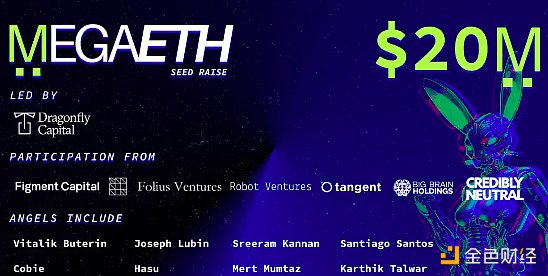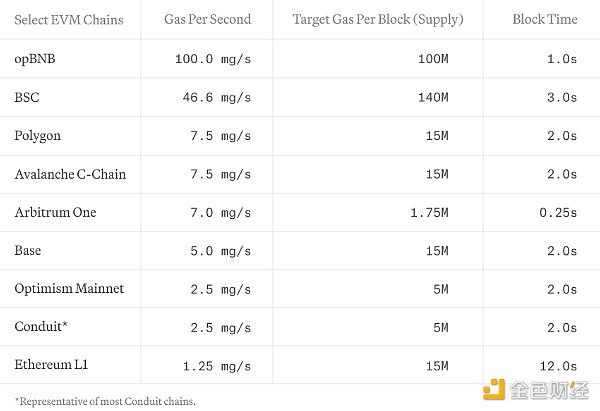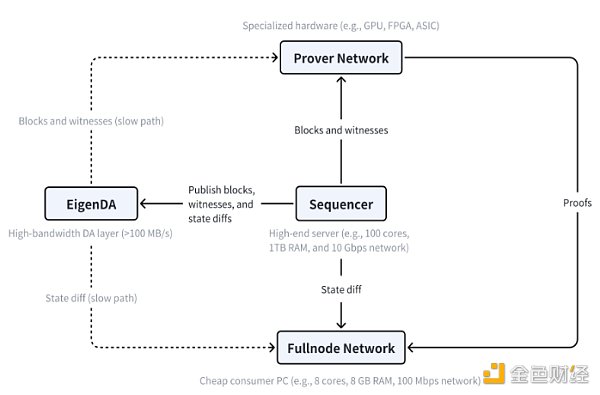Written by: 0xjs@黄金财经
According to l2beat data, there are already more than 50 L2s on the market.
But recently, another EVM L2 public chain MegaETH has emerged in the crypto market, and has received $20 million in seed round financing, led by crypto VC Dragonfly Capital, with participation from Figment Capital, Folius Ventures, Robot Ventures, Big Brain Holdings, Tangent and Credible Neutral. In addition, it has also received investments from famous angel investors such as Vitalik Buterin, Consensys founder Joseph Lubin, Sreeram Kannan, Cobie, Karthik Talwar, Hasu, Santiago and Mert.

What kind of public chain is MegaETH? What is the charm that can attract so many luxurious investment lineups?
There are so many L1/L2 already, why do we need a MegaETH?
The advancement of blockchain frameworks has greatly reduced the threshold for creating new chains (including L1 and L2). As a result, a large number of new public chains have emerged recently. According to l2beat data, there are currently more than 50 L2 projects.
However, simply creating more chains does not solve the problem of blockchain scalability, because each individual chain still imposes significant restrictions on the dApps it hosts. For example, the table below shows the target gas per second and block time for today's major EVM chains.

The table above clearly shows that existing EVM chains face significant limitations in several aspects. First, they all exhibit low transaction throughput. For example, while opBNB stands out among its peers with an extremely high gas rate of 100 MGas/s, it still pales in comparison to the capabilities of modern Web2 servers. For reference, 100 MGas/s is equivalent to only 650 Uniswap swaps or 3,700 ERC-20 transfers per second. In comparison, modern database servers already exceed one million transactions per second in the TPC-C benchmark.
Second, complex applications cannot be put on-chain due to the scarcity of computing power. For example, a simple EVM contract calculating the ?th (n=10 to the 8th) Fibonacci number consumes about 5.5 billion gas, which would take the entire opBNB chain 55 seconds to calculate at a speed of 100 MGas/s. In contrast, a similar program written in C only takes 30 milliseconds to complete the same task, making it 1833 times faster using a single CPU core! Now imagine the possibility of leveraging multi-core processing to unlock another 100 times the computing power of the blockchain.
Finally, applications that require high update rates or fast feedback loops are not feasible with long block times. With the exception of Arbitrum One, all chains in the table update their state every second or more. However, complex fully on-chain dApps like Autonomous World require high update rates (e.g., less than 100 milliseconds between blocks) to simulate real-time combat or physics. Furthermore, high-frequency trading on the chain is impossible unless orders can be placed or canceled within 10 milliseconds.
Fortunately, none of these limitations are insurmountable for EVM chains. As technology advances, it’s time to build a real-time blockchain to unlock these potentials. A real-time blockchain is one that can process transactions as soon as they arrive and publish result updates in real time. In addition, it must support high transaction throughput and strong computing power to maintain a real-time experience even during peak user demand.
MegaETH’s goal is to be an EVM-compatible real-time blockchain, with the goal of pushing the performance of Ethereum L2 to the hardware limit, narrowing the gap between blockchain and traditional cloud computing servers, and bringing Web2-level real-time performance to the crypto world for the first time.
MegaETH’s six features enable real-time EVM
According to Shuyao Kong, co-founder of MegaETH, MegaETH is the first real-time blockchain that supports 100,000 transactions per second and millisecond response speeds.
MegaETH achieves the above real-time EVM performance through the following 6 key technologies:
1. Node specialization: MegaETH concentrates performance-critical tasks such as transaction execution to a small group of sorter nodes, while massively decentralizing security-critical tasks such as block verification. This key architectural decision enables MegaETH to significantly improve network performance while minimizing the hardware requirements of full nodes. The end result is an unprecedentedly fast, secure and efficient heterogeneous blockchain.
2. Real-time EVM execution engine: MegaETH has launched the first real-time EVM execution engine that can seamlessly process large numbers of transactions as they arrive and reliably publish the resulting state changes at intervals as low as 10 milliseconds. This unique feature is achieved by co-designing MegaETH's low-latency, stream-based block building algorithm with a concurrency control protocol that supports transaction priorities.
3. In-memery computing: MegaETH's sorter stores the entire EVM world state and state trie in memory, which speeds up state access by 1,000 times compared to SSD-based systems. High-end servers with 1-4 TB of memory are readily available in the cloud, providing ample capacity for future state growth. This technology, known as in-memory computing, is critical for high-performance, data-intensive Web2 applications. Thanks to node specialization, MegaETH is bringing this cutting-edge technology to the blockchain for the first time.
4. Smart contract compilation: MegaETH uses just-in-time (JIT) compilation technology to transparently convert smart contracts into native machine code on the fly. This technology eliminates the inefficiencies of interpreting EVM bytecode and emulating stack machines. For compute-intensive applications, it can improve performance by 100 times, making MegaETH an ideal platform for building complex dApps with real-time performance
5. Super IO Efficiency State Trie: Maintaining the state trie is the biggest bottleneck for EVM-compatible blockchains due to intensive disk I/O operations. MegaETH solves this problem by replacing the Merkle Patricia Trie (MPT) with a new state trie designed from scratch. This new trie minimizes disk I/O and efficiently scales to TB-level state data while maintaining full EVM compatibility.
6. State Synchronization Protocol: MegaETH uses an efficient peer-to-peer protocol to propagate state updates from sorters to full nodes with low latency and high throughput. This ensures that even nodes with poor network connectivity can keep up with the latest state, even at an update rate of 100,000 TPS.
MegaETH Components
There are three main roles in MegaETH: sorter, prover, and full node.

MegaETH 's main components and their interactions
The sorter is responsible for sorting and executing user transactions. But MegaETH has only one active sorter at any given time, eliminating consensus overhead during normal execution.
Most full nodes receive state diffs from this sorter through the p2p network and directly apply these differences to update the local state. It is worth noting that they do not re-execute transactions; instead, they indirectly verify blocks using the proofs provided by the prover. Advanced users such as bridge operators and market makers may still execute each transaction for fast finality, although higher hardware is required to keep up with the sequencer.
Provers use a stateless verification scheme to verify blocks in an asynchronous and unordered manner.
MegaETH Highly Knowledgeable Founding Team
MegaETH was able to receive investment from industry celebrities such as Dragonfly Capital and other crypto VCs Vitalik, thanks in large part to its luxurious founding team.
According to the official website, the main founding team of MegaETH consists of 4 people:

Li Yilong: Co-founder and CEO, Ph.D. in Computer Science from Stanford University, and worked at the software company Runtime Verification Inc.;
Yang Lei, co-founder and CTO: Received a Bachelor of Science in Computer Science from Peking University in 2018, a Master of Science from MIT in 2020, and recently received a Ph.D. in Computer Science from MIT. He is a member of the MIT CSAIL Network and Mobile Systems Group; his doctoral thesis is on effective consensus and synchronization of distributed systems.
Kong Shuyao, co-founder and CBO, joined Consensys in 2017 and served as the head of global business development at Consensys. She graduated from Harvard Business School in 2020 and joined MegaETH in March 2024. She is also a columnist for Decrypt.
Namik Muduroglu, founding member and head of growth, works at Consensys and Hypersphere.
 JinseFinance
JinseFinance
 JinseFinance
JinseFinance JinseFinance
JinseFinance JinseFinance
JinseFinance JinseFinance
JinseFinance JinseFinance
JinseFinance JinseFinance
JinseFinance JinseFinance
JinseFinance JinseFinance
JinseFinance Edmund
Edmund Coindesk
Coindesk